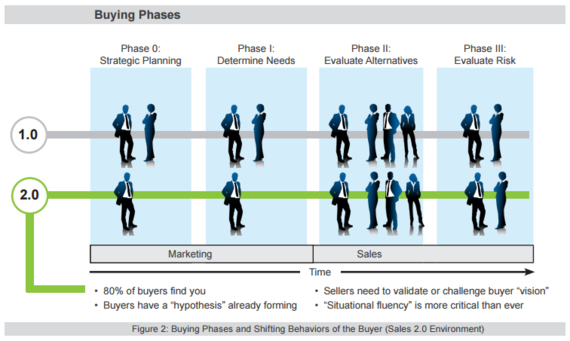Co-authored by Andrew Borque, featured in Huffington Post. Bottom line: Evolve with the buyer and do so by leveraging technology.
Salesmanship is arguably the world’s oldest and most timeless profession. While innovation has driven the evolution of man for millions of years, salesmanship (alongside marketing) has been the engine that keeps innovation running. Walter A. Friedman’s Birth of a Salesman goes as far as to suggest that sales men — and women — are much of the reason America transitioned from a producer to a consumer society.
A 1955 Journal of Retailing article by Victor Lebow, “Price Competition in 1955” is now often quoted as much:
“Our enormously productive economy…demands that we make consumption a way of life, that we convert the buying and use of goods into rituals, that we seek our spiritual satisfaction, our ego satisfaction, in consumption…we need things consumed, burned up, replaced and discarded at an ever-accelerating rate.”
So here we are in 2015 in a truly consumer-centered world. Gone are the days of street peddlers and door-to-door sellers and yet among all the change one thing is constant: Success in sales still requires a product/service and sales strategy that evolves with the buyer, which is easier said than done.
Today’s modern buyer (Buyer 2.0) is self-evaluating the value of a product or service on websites, social networks, review boards and hundreds of digital resources. Buyer 2.0 is not going to act exclusively by the sales pitch drummed up by a company representative — the wealth of information accessible to the modern buyer with a tap, swipe and search is simply too profound for such a narrow sales evaluation. In fact, the Buyer 2.0 is 60-90 percent through the decision-making stage of a sale before engaging with a sales professional.
Sales Performance International breaks down the evolution of Buyer 2.0, as such:

Sales professionals can pull up an influential seat at the buyer’s table only if they know when, where and how to enter the buyer’s decision-making process. Joergen Aaboe, a marketing executive who has partnered with B2B sales teams for the last decade said “Smart sales organizations are acting on the ‘Jab, Jab, Jab, Right Hook‘ message from Gary Vaynerchuk. Selling today is about delivering value to prospects through content and other forms of education and engagement — jabbing — before coming in with the pitch.” To keep up with the Buyer 2.0, thousands of sales and marketing professionals flock to Sales 2.0 Conference for modern sales practices and technologies that increase sales performance. Glance at their agenda and it’s evident that modern sales practices focus on joining the buyer’s band wagon and taking advantage of the ride. Here are three modern sales practices helping organizations increase sales performance:
- Align marketing, sales and customer service to grow revenue.
In theory, this is obvious but in practice, few companies do this successfully and to scale. Alignment enables support or service that better bridges to a sale. It enhances product management by establishing a live feedback loop from customer service to marketing and allows organizations to refine message development for sales based on customer feedback findings. - Invest in social selling that educates and engages with buyers upfront.
According to an IDC social buying study, more than 83 percent of buyers used social media to explore, gain knowledge and evaluate potential providers. Taking that one step further is the concept of crowdsourced selling. Founder of QuotaDeck.com, Bubba Page says, “Cold calling/emailing is dead. With an average 1-2 percent success rate and a miserable experience for both the person making them and receiving them. Social Selling is known to help salespeople find prospects through social media, which can help you narrow down who might be interested in your product. But the future of social selling is crowdsourced selling, at QuotaDeck, crowdsourcing introductions has shown to increases your conversion rates 10x over anything cold. It’s time we bring the collaborative economy to B2B selling.” - Adopt sales analytics and productivity tools to stay efficient enough to keep up with consumers.
There are hundreds of tools out there but the must-haves use data and technology to provide predictive analytics, audience intelligence and both ground and sky views of buyer behavior. Take 6sense for example, their predictive intelligence solution uncovers net-new companies, contacts and prioritizes known prospects ready to buy now. Cisco leverages 6sense to predict with 80 percent accuracy what a company or contact will buy and when.
This shift in buying behavior is driven by digital access to action and resources that impact buying behavior. While the shift puts the power in the customer’s hands and demands organizations of all sizes to adapt quickly, it can provide incredible insight into their buyers.
The secret? Evolve with the buyer and do so by leveraging technology.
